
This is an educational simulator for evaluating both the downlink and uplink performance of the LTE Advanced technology. Turbo-coded OFDMA for downlink and SC-FDMA for uplink are considered. Both direct transmission and relaying are considered. This simulator is especially useful for research students working on wireless communication technologies. It is also a useful resource for network engineers to plan for the placement of base station and relay station for a given geographical map.
By taping the info button at the top left corner, users can modify the simulation parameters including modulation scheme, node speed, channel model, the number of users and the image for display. The transmit Signal to Noise power Ratio (SNR) and Path Loss can also be edited. User can choose to use the current location as the center of the Googlemap. Alternatively, user can choose to use any other location as well as zooming in and out of the map. When the bottom right button is turned to ON, the Base station (B), Relay node (R) and User nodes (U) will appear on the map. Users can tap the nodes to activate (or deactivate) their movements. The nodes can also be dragged to different locations on the map.
The simulator will show the corresponding received SNR (SNRr), distance between B and U as well as the Bit Error Rate (BER). When direct transmission between B and U is poor, a relay node will be employed for Amplify-And-Forward (AAF) or Decode-And-Forward (DAF) the source message from B to U (in the downlink) or U to B (in the uplink). Cooperative cognitive ratio technology is also employed for investigating the potential bandwidth (BW) saving. The calculation of the BW saved is based on the following research papers:
[1] W. Liang, S. X. Ng and L. Hanzo, "Adaptive turbo trellis coded modulation aided cooperative cognitive radio", in IEEE Wireless Communications and Networking Conference (WCNC), Paris, 01 - 04 Apr 2012.
[2] W. Liang, S. X. Ng and L. Hanzo, "Cooperative Communication Between Cognitive and Primary Users", IET Communications, June 2013.
Huffman coding is used to encode the image selected from the simulation parameter page. Images can be selected from:
1) Camera
2) Photo Album
3) Pre-stored images: including Scooby Doo (Cartoon) and planets (Science).
When the D button at the top right corner is tapped at the simulation page, the original image selected will be displayed at the top left corner while the decoded (possibly corrupted) image will be displayed at the top right corner.
